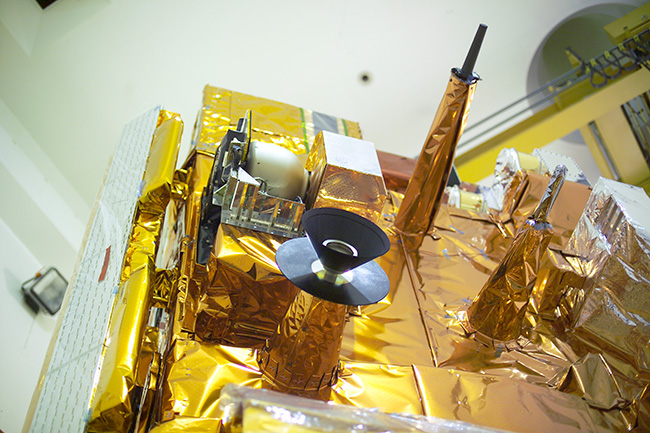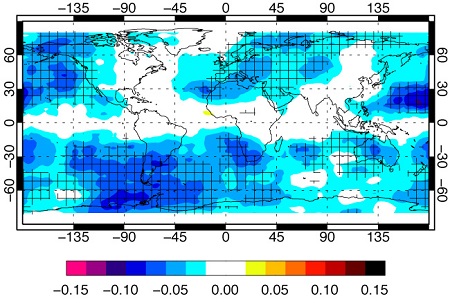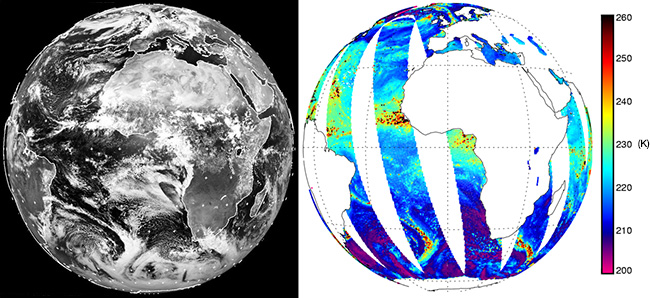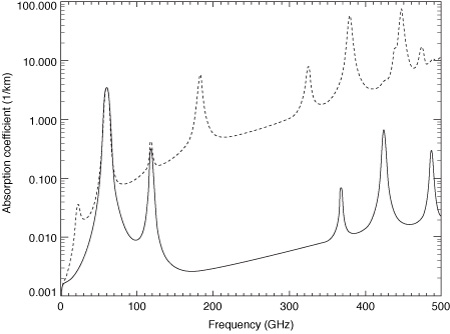

How best to use satellite observations of microwave signals affected by clouds and precipitation in numerical weather prediction is a thorny problem.
ECMWF scientists including Alan Geer have been working on it for many years – with remarkable success.
Today ‘all-sky’ microwave humidity sounding observations are routinely used at ECMWF to improve the accuracy of the initial conditions on which forecasts are based.
The impact has been nothing short of phenomenal.
At ECMWF satellite measurements of radiances affected by humidity, clouds and precipitation now make one of the most significant contributions to weather forecasts compared to other parts of the observing system.
Getting there has not been easy.
“Traditionally humidity was not considered a crucial variable to use to initialise forecasts,” Dr Geer points out.
“Variables more closely linked to the dynamics of the atmosphere, such as wind, temperature and pressure, were regarded as more important.”
Indeed, early attempts to assimilate microwave radiances affected by humidity failed to produce much benefit.
“Over the years we have learnt to exploit microwave radiance measurements, including in all-sky conditions, to obtain useful information on dynamical variables.”
A physicist by training with a PhD in remote sensing, Dr Geer joined ECMWF in 2006. He is now a senior scientist in the Research Department and ECMWF’s top specialist on all-sky assimilation.
|
|
The impact of microwave radiances sensitive to water vapour, cloud and precipitation on ECMWF forecasts has grown steadily over the years relative to that of other parts of the observing system. This is shown here in terms of forecast sensitivity to observation impact (FSOI) in the ECMWF operational system from June 2012 to October 2016, averaged in 25-day bins and normalised so the total impact is 100%. |
Inferring weather from radiances
Weather observations are crucial in numerical weather prediction (NWP) to help achieve the best possible representation of the current state of the atmosphere.
A weather forecast is produced by using the laws of physics to evolve that state forward in time.
The observations come from many sources, including weather stations, radiosondes, ships, aircraft and satellites.
Among these, satellite observations have become particularly important as they provide excellent coverage of every corner of the globe.
But satellite instruments cannot measure weather parameters such as wind, temperature or humidity directly.
What they measure is the intensity of radiation at different frequencies at the top of the atmosphere.

Data from 11 humidity-sensitive satellite microwave sensors are now assimilated at ECMWF. Nine of these sensors use the all-sky approach. This photo shows the payload of EUMETSAT’s MetOp-A satellite. The Microwave Humidity Sounder is the centrally positioned box on the left. Much of the pioneering 'all-sky' work carried out by ECMWF scientists was funded by EUMETSAT via Fellowships at ECMWF. (Photo: ESA/S. CORVAJA)
“Sophisticated methods are needed to make these measurements useful for NWP by inferring from them information on temperature, winds, humidity and other variables at different levels of the atmosphere,” says Dr Geer.
Direct assimilation
An early approach was to first convert radiances into temperature and moisture information, which was then fed into the data assimilation system.
This method did not prove particularly successful.
“Substantial improvements were achieved when the radiances were directly ingested into the data assimilation system,” Dr Geer notes.
The system can then work out how best to adjust all the variables it handles to provide a good match with the observed radiances as well as other observations.
The assimilation of microwave radiances may thus directly lead to adjustments of dynamical variables, such as wind, temperature and pressure.
|
|
Air absorbs microwave radiation to different degrees depending on the frequency of the radiation and on whether the air is dry (solid line) or moist (dashed line). To measure humidity, it is convenient to measure microwave radiances at frequencies with strong water vapour absorption in moist air only, such as at 22 GHz and 183 GHz. The absorption coefficient lines shown here are valid for a temperature of 288 K and atmospheric pressure of 1,000 hPa. |
Winds from radiances
How exactly do microwave radiance observations related to humidity help us to obtain information on, say, winds?
The first difficulty lies in correctly interpreting the observations.
Any particular radiance measurement could be the result of any number of humidity profiles.
However, help is at hand from our prior knowledge of atmospheric humidity.
The data assimilation system works out what kind of radiances satellite instruments would see if our prior information were correct. Then it compares those simulated radiances with the observed radiances.
The comparison helps to determine how the system needs to update humidity profiles and other variables in the model to achieve a good match with observations.
For example, updated humidity fields imply updated motions of such fields. These in turn imply updated wind fields since the humidity fields act as a tracer for wind.

A paper boat floating on a river can serve as a tracer element to show the speed and direction of surface currents. Similarly, the motion of humidity fields in the atmosphere can provide information on the speed and direction of winds. (Photo: Mr_Twister/iStock/Thinkstock)
The importance of all-sky
There was a time when microwave humidity sounding observations were only assimilated in ‘clear-sky conditions’, i.e. in the absence of clouds and precipitation.
This was because microwave radiances are affected by clouds and precipitation in ways which make the resulting signal difficult to interpret.
But only using clear-sky observations meant that parts of the globe were not covered, leading to significant data gaps. All-sky assimilation also makes it possible to exploit cloud and precipitation observations to help infer initial conditions.
“Much effort has therefore been put into our ability to interpret cloud and precipitation-affected radiances correctly,” Dr Geer observes.
These efforts have paid off handsomely.
All-sky assimilation has roughly doubled the impact of microwave radiances on forecast performance compared to clear-sky assimilation.
For example, the clear-sky assimilation of microwave humidity sounding observations extends the skilful range of forecasts in the southern hemisphere by about three quarters of an hour, while all-sky assimilation extends it by about one and a half hours.

The all-sky assimilation of microwave radiances has brought big reductions in error. This chart shows the normalised difference in root-mean-square error of 500 hPa geopotential height between three-day forecasts using all-sky assimilation from seven satellites and control forecasts not using those data. Blue areas indicate where all-sky assimilation reduces forecast errors. Cross-hatching indicates statistical significance at the 95% confidence level. The figures are based on six months of experimentation.
In one particular case, the data assimilation system detected excessive weather front precipitation in the model compared to microwave radiance observations.
It then reduced the strength of a low pressure system 1,000 km away 12 hours earlier to achieve a better match with the observed radiances.
This illustrates how all-sky assimilation can lead to significant improvements in the analysed state of the atmosphere, which in turn enables the production of better forecasts.

A view of the Earth at around midday on 24 August 2008, as observed in visible (left) and microwave (right) frequencies. In the visible frequencies, clouds scatter radiation, meaning that from space they are seen as bright features against a dark background. In the microwave frequency chosen here (37 GHz), radiation penetrates the clouds but not heavy rain. The areas emitting the most radiation, shown here in terms of brightness temperatures, correspond to areas of rain within and under the clouds. The visible data comes from a geostationary satellite, Meteosat, but the microwave data is from the AMSR-E instrument flying on a polar-orbiting satellite, so the microwave image is made up of a number of separate swaths. (Left-hand image: NERC Satellite Receiving Station, Dundee University, Scotland, www.sat.dundee.ac.uk/)
At the cutting edge
All-sky assimilation requires us to fine-tune the simulation of microwave radiances in precipitation situations.
This is far from straightforward.
“The generation of raindrops, snowflakes and other hydrometeors and the way in which they affect microwave radiances are intricate processes of which we have incomplete knowledge,” says Dr Geer.
“We therefore have work to do in two areas: improving the representation of hydrometeors in our model; and improving our understanding of how microwave radiances are affected by such particles.”
Another active area of research is the development of all-sky assimilation for infrared radiances.
Many numerical weather prediction centres are working on the problem, including ECMWF.
“We have developed the all-sky assimilation of infrared radiances to a proof-of-concept stage, where we can clearly see that it can bring benefits,” says Dr Geer.
“We are hoping to move to the operational stage over the next couple of years. We intend to stay at the cutting edge of research in this area.”

The shape and size of hydrometeors such as snowflakes influence the way in which microwave radiances are affected by precipitation. More research is needed to gain a better understanding of the processes involved. (jefunne/iStock/Thinkstock)
Top image (ESA/EUMETSAT): Artist’s impression of one of EUMETSAT’s Met-Op satellites, which carry the Microwave Humidity Sounder instrument.


